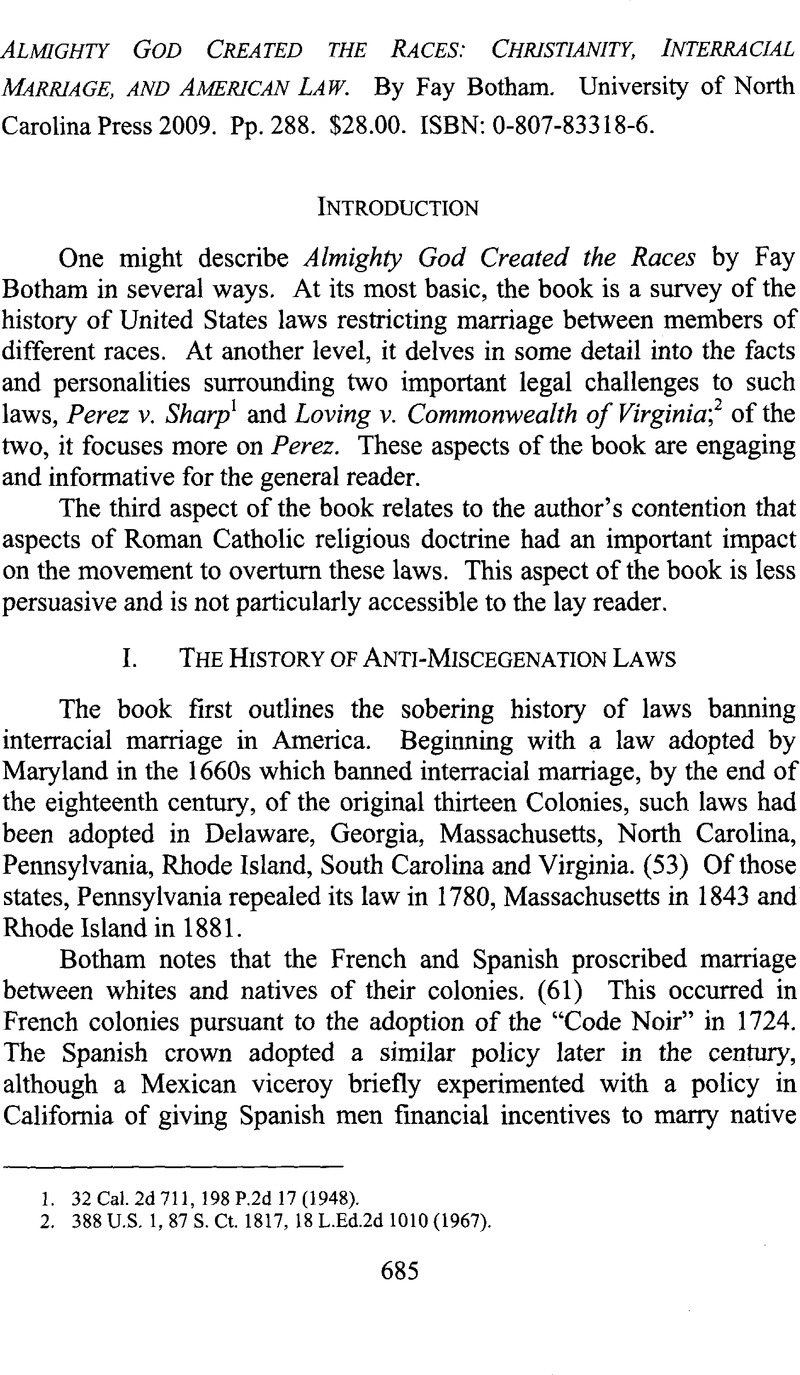No CrossRef data available.
Article contents
Almighty God Created the Races: Christianity, Interracial Marriage, and American Law. By Fay Botham. University of North Carolina Press2009. Pp. 288. $28.00. ISBN: 0-807-83318-6.
Review products
Published online by Cambridge University Press: 24 April 2015
Abstract

- Type
- Book Reviews
- Information
- Copyright
- Copyright © Center for the Study of Law and Religion at Emory University 2010
References
1. 32 Cal.2d 711, 198 P.2d 17 (1948).
2. 388 U.S. 1, 87 S. Ct. 1817, 18 L.Ed.2d 1010 (1967).
3. During the 19th century, such laws were abolished in Iowa (1851), Kansas (1857), Maine (1883), Massachusetts (1840), Michigan (1883), New Mexico (1886), Ohio (1887), Rhode Island (1881) and Washington (1867). See Note, A Study of the Wyoming Miscegenation Statutes, 10 Wyo. L.J. 131 n. 2 (1956)Google Scholar (listing the state miscegenation statutes); Appelbaum, Harvey M., Miscegenation Statutes: A Constitutional and Social Problem, 53 Geo. L.J. 49, 50 n. 10 (1964)Google Scholar.
4. See Appelbaum, supra note 3, at 50 n. 9.
5. Id. at 51-52. See generally Pascoe, Peggy, Miscegenation Law, Court Cases, and Ideologies of “Race” in Twentieth- Century America, 83 J. Am. Hist. 44, 49 (1996)CrossRefGoogle Scholar; Note, Constitutionality of Anti-Miscegenation Statutes, 58 Yale L.J. 472, 480 (1948–1949) (Appendix I listing state anti-miscegenation statutes)Google Scholar.
6. Appelbaum, supra note 3, at 50 n. 11.
7. 106 U.S. 583, 1 S. Ct. 637, 27 L. Ed. 207 (1883).
8. Stevens v. U.S., 146 F.2d 120 (10th Cir. 1944).
9. See Sides, Josh, L. A. City Limits: African American Los Angeles from the Great Depression to the Present 36 (Univ. Cal. Press 2003)Google Scholar.
10. Id. at 16-18, 48-49.
11. For a summary of such laws, see Note, supra note 5.
12. See Note, supra note 3.
13. See Volpp, Leti, American Mestizo: Filipinos and Antimiscegenation Laws in California, 33 U.C. Davis L. Rev. 795, 821–22 (2000)Google Scholar.
14. See Mayeri, Serena, The Strange Career of Jane Crow: Sex Segregation and the Transformation of Anti-Discrimination Discourse, 18 Yale J.L. & Human. 187, 204 (2006) (1958 Gallup poll found that five percent of all non-Southern whites approved of a marriage between a white and a black)Google Scholar.
15. See Lenhardt, R.A., Beyond Analogy: Perez v. Sharp, Antimiscegenation Law and the Fight for Same-Sex Marriage, 96 Cal. L. Rev. 839, 843 n. 19 (2008)Google Scholar.
16. In California, Hispanics historically had been considered white for purposes of the law. See Orenstein, Dara, Void for Vagueness: Mexicans and the Collapse of Miscegenation Laws in California, 74 Pac. Hist. Rev. 367, 369 (2005)CrossRefGoogle Scholar.
17. Indeed, other prominent civil rights lawyers in Los Angeles did not join Marshall in the case “on the assumption that the statute could not be successfully challenged.” See Orenstein, supra note 16, at 392 (quoting Carey McWilliams, another California lawyer).
18. Exec. Order No. 9981, 13 Fed. Reg. 4313 (July 26, 1948).
19. Brown v. Bd. of Educ. of Topeka, 347 U.S. 483, 74 S. Ct. 686, 98 L. Ed. 873 (1954).
20. See Lenhardt, supra note 15, at 857 n. 108.
21. Civil Rights Act 1964, Pub. L. 88-352, 78 Stat. 241 (1964).
22. 379 U.S. 184, 85 S. Ct. 283, 13 L. Ed. 222 (1964).
23. See generally Appelbaum, supra note 3.
24. (The Virginia Statutory sections are reproduced in the Supreme Court's Loving opinion.) For a discussion of the history of the Virginia statute, see generally Wadlington, Walter, The Loving Case: Virginia's Anti-Miscegenation Statute in Historical Perspective, 52 Va. L. Rev. 1189 (1966)CrossRefGoogle Scholar.
25. See Pascoe, supra note 5, at 65.
26. For an example of this, see “Race Mixing and the Bible: The Christian View of Segregation,” Truth & Liberty Magazine 10 1957, at 39–40Google Scholar.
27. For a discussion of this topic, see generally Freidland, Michael, Lift up Your Voices Like a Trumpet: White Clergy and the Civil Rights and Antiwar Movements 1954-1973 (Univ. N.C. Press 1998)CrossRefGoogle Scholar; Finley, James, Religion and Politics in the Sixties: The Churches and the Civil Rights Act of 1964, 77.1J. Am. Hist. 66 (06 1990)Google Scholar. See, e.g., The Protestant Desegregation Drive, The Shreveport Times 06 30, 1963, at 5Google Scholar.
28. There was significant disagreement within Protestant churches regarding integration. See Hadden, J.K., The Gathering Storm in the Churches (Doubleday 1969)Google Scholar; Wood, J.R., Authority and Controversial Policy, 35 Am. Soc. Rev. 1057 (1970)CrossRefGoogle ScholarPubMed.
29. Brown, Robert Mcafee, Reflections Over the Long Haul 93 (Westminster John Knox Press 2005)Google Scholar.
30. These restrictions apparently were lifted by 1965. In Jerald Brauer's 1965 book about the 1965 march from Selma to Montgomery Alabama, he mentions that Dr. King was joined by “hundreds of clergymen-Protestant, Catholic, and Jewish.” See Brauer, Jerald, Protestantism in America: A Narrative History ch. 18 (Westminster John Knox Press 1965), available at www.religion-online.org/showchapter.asp?title=1663&C=1672Google Scholar.


